 W
WAmolops formosus is a species of frog found in high gradient streams of northern India, northern Bangladesh, and Nepal.
 W
WThe banded bullfrog is a type of frog in the microhylid family. It is also known as the Asian painted frog, rice frog, and bubble frog. In the pet trade, it is sometimes called the chubby frog. They have round bodies with mahogany brown backs and cream stomachs. The distinctive stripes down the side can range from copper-brown to salmon pink in color. Males have darker throats than females. Frogs grow to about 8 cm (3 in) with females generally being larger than males. They may live for as long as 10 years. Although prevalent in the pet trade, very little is known regarding its behaviour in the wild. They exude a sticky mucus when threatened.
 W
WChirixalus doriae, commonly known as Doria's Asian treefrog, Doria's bush frog, Doria's bush frog, and Doria's tree frog, is a species of frog in the family Rhacophoridae. It is found in southeastern Asia, from extreme northeastern India and adjacent Bangladesh to Myanmar, Thailand, Cambodia, Laos, Vietnam, and southern China.
 W
WChirixalus simus, commonly known as Assam Asian frog, Assam tree frog, Annandale's tree frog, and Annandale's pigmy tree frog, is a species of frog in the family Rhacophoridae found in Bangladesh and north-eastern India. Among other places, it has been recorded from Rajpur in the South 24 Parganas district and in the Darrang district of Assam.
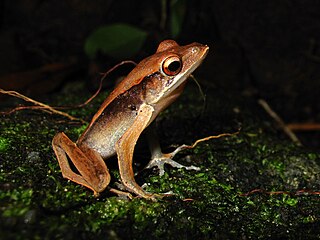 W
WClinotarsus alticola is a species of frog in the family Ranidae. Common names for this species include: Assam Hills frog, Annandale's frog, pointed-headed frog, palebrown stream frog, hill frog, point-nosed frog, and high-altitude frog. It is found in Hills of Meghalaya and northeastern India to northern Bangladesh, possibly into Bhutan and Nepal.
 W
WPolypedates leucomystax is a species in the shrub frog family Rhacophoridae. It is known under numerous common names, including common tree frog, four-lined tree frog, golden tree frog or striped tree frog. Many past authors have united it with the common Indian tree frog in P. maculatus, but today they are generally considered distinct species. In its native range, it is also called "white-lipped tree frog", but this name is otherwise applied to a species of true tree frogs.
 W
WDuttaphrynus himalayanus, also known as the Himalaya toad, Himalayan toad, Himalayan broad-skulled toad, and Günther's high altitude toad, is a species of toad that is widely distributed throughout the Himalayan mountains. The Yunnanese populations are sometimes considered a separate species, Duttaphrynus cyphosus.
 W
WDuttaphrynus melanostictus is commonly called Asian common toad, Asian black-spined toad, Asian toad, black-spectacled toad, common Sunda toad, and Javanese toad. It is probably a complex of more than one true toad species that is widely distributed in South and Southeast Asia.
 W
WDuttaphrynus stomaticus, also known as the Indian marbled toad, Punjab toad, Indus Valley toad, or marbled toad, is a species of toad found in Asia from eastern Iran, Pakistan, Afghanistan to Nepal, extending into Peninsular India and Bangaldesh.
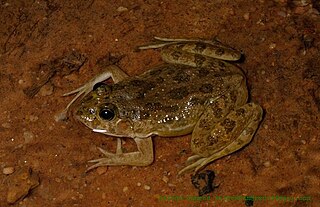 W
WEuphlyctis cyanophlyctis is a common dicroglossid frog found in South Asia. It is known under numerous common names, including Indian skipper frog or skittering frog. They are often seen at the edge of bodies of water with their eyes above the water. They noisily move away from the shore when disturbed, giving them their common name. They are rarely seen outside water.
 W
WEuphlyctis hexadactylus, also known as the green pond frog, Indian green frog, and Indian five-fingered frog, is a common species of aquatic frog found in Pakistan, India, Bangladesh, and Sri Lanka. The nominal taxon likely represents a species complex.
 W
WFeihyla vittata is a species of frog in the family Rhacophoridae. It is found in Northeast India, Bangladesh, Myanmar, Thailand, Cambodia, Laos, and Vietnam, as well as in isolated populations in southern China. Many common names have been coined for it: two-striped pigmy tree frog, Bhamo tree frog, Boulenger's tree frog, striped Asian treefrog, violet pigmy tree frog, and lateral-striped opposite-fingered treefrog.
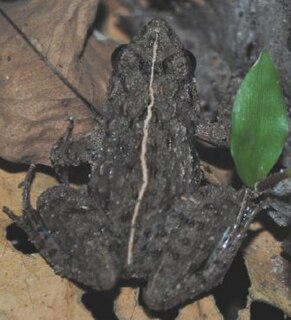 W
WZakerana nepalensis is a small-sized frog native to northern and northeastern India, Bangladesh, and Nepal. It has recently been reported also from Bhutan. Having distinct and narrow middorsal line (MDL); indistinct skin fringe on outer side of 5th toe; relative finger length (RFL) is 2<1<4<3, 1st finger scarcely longer than 2nd; laterally dark and medially pale throat in males; body tubercles oblong, arranged in longitudinal folds; and snout jutting over jaw.
 W
WThe green puddle frog, rough-skinned floating frog, pearly skin puddle frog, or pointed-tongued floating frog is a species of frog in the family Dicroglossidae. It is found in Bangladesh, Cambodia, China, Hong Kong, India, Indonesia, Laos, Malaysia, Myanmar, Thailand, Vietnam, and possibly Nepal.
 W
WHoplobatrachus crassus, also called Jerdon's bullfrog, Jerdon's bull frog, and South Indian bullfrog, is a species of frog found widely distributed on the plains of India, Bangladesh, Nepal, and Sri Lanka. Its range may extend to the adjacent Bhutan and Myanmar.
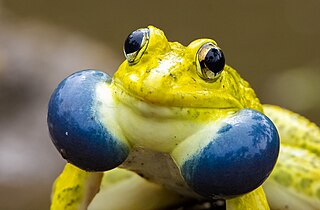 W
WHoplobatrachus tigerinus, the Indus Valley bullfrog or Indian bullfrog, popular name Asian bullfrog, Asean bullfrog or Asia bullfrog, is a large species of frog found in mainland Myanmar, Bangladesh, India, Pakistan, Afghanistan, and Nepal. It has been introduced in Madagascar and India's Andaman Islands, where it is now a widespread invasive species.
 W
WHumerana humeralis is a species of frog in the family Ranidae. It is found in Bangladesh, India, Myanmar, Nepal, and possibly Bhutan. Its natural habitats are subtropical or tropical moist lowland forests and rivers. It is threatened by habitat loss.
 W
WHylarana leptoglossa, commonly known as the long-tongued frog, is a species of true frog in the genus Hylarana. It is native to Bangladesh, northeastern India, Myanmar, and western Thailand. It is also known under the common names Cope's frog, Cope's Assam frog, palebrown small frog, and Assam forest frog. It has recently been reported also from Bhutan.
 W
WHylarana taipehensis is a species of true frog, family Ranidae. It has several common names, including Taipei frog, Taipei grass frog, two-striped grass frog, or striped slender frog. It is found in northeastern India, Bhutan, Bangladesh, Myanmar, Thailand, Cambodia, Laos, Vietnam, southern China, Hong Kong, and Taiwan. There is some uncertainty about the identity of specimens from India.
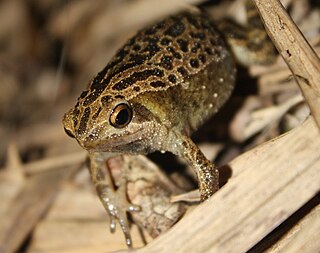 W
WKalophrynus interlineatus, commonly known as the spotted narrow-mouthed frog, is a species of narrow-mouthed frog found in India and South East Asia including Hong Kong.
 W
WMicrohyla berdmorei is a species of narrow-mouthed frog found in eastern India, Bangladesh, southernmost China (Yunnan), Mainland Southeast Asia as well as Borneo and Sumatra. Frogs from Bangladesh probably represent an unnamed species.
 W
WMicrohyla ornata. commonly known as the ornate narrow-mouthed frog, ornate narrow-mouthed toad, or ornamented pygmy frog, is a species of microhylid frog found in South Asia. This amphibian is distributed in Kashmir, Nepal, peninsular India and the Andaman and Nicobar Islands, Sri Lanka, and Bangladesh. It was previously considered to be the same species as Microhyla fissipes; therefore, the aforementioned common names can refer to either species.
 W
WThe northern frog, or the Rotung oriental frog is a species of frog in the family Dicroglossidae. It is found in Bangladesh, Bhutan, northeastern India, Tibet, Nepal, and western Myanmar.
 W
WRaorchestes parvulus is a species of frog in the family Rhacophoridae. It is found from eastern Bangladesh east through Myanmar and Thailand to Cambodia, northern Vietnam, Laos, and Peninsular Malaysia. Its distribution might well extend into northeastern India and southern China. This species was first described by George Albert Boulenger based on seven specimens collected by Leonardo Fea from Karen Hills, Burma.
 W
WRhacophorus bipunctatus is a frog species in the moss frog family (Rhacophoridae) found from eastern India into Southeast Asia, possibly to southeastern China and south to Malaysia. Due to the identification problems surrounding this species, the eastern and southern limits of its range remain undetermined; all that is known is that the species certainly occurs in the border region of India, Bangladesh, China and Myanmar; its range might extend south to Malaysia, as similar frogs have been reported from Pahang.
 W
WSylvirana nigrovittata, also known as the black-striped frog, black-spotted stream frog, sapgreen stream frog, etc., is a species of frog in the family Ranidae. It is found in northeastern India, Bangladesh, Nepal, southern China, Myanmar, Thailand, Cambodia, Laos, and Vietnam. The species was redelimited in 2018, and earlier literature may refer to other species; identifications from India and Bangladesh are still uncertain.
 W
WUperodon globulosus, or Indian balloon frog, is a species of narrow-mouthed frog found in India, Nepal, and Bangladesh. It is known under many common names: Indian globular frog, Indian balloon frog, grey balloon frog, and greater balloon frog. Specimens from the Western Ghats may represent an undescribed species.
 W
WUperodon taprobanicus, also known as the Sri Lankan bullfrog, common bullfrog, Sri Lankan painted frog, Sri Lankan kaloula, Ceylon kaloula, Indian painted frog, or painted globular frog, is a species of narrow-mouthed frog found in Nepal, Bangladesh, southern and eastern India, and Sri Lanka up to an altitude of about 1300 metres. It is a common species, the adult of which is up to 75 millimetres long from snout to vent. It was originally described as a subspecies of Kaloula pulchra, ssp. taprobanica. The IUCN lists it as being of "Least Concern".
 W
WZakerana pierrei is a species of frog in the family Dicroglossidae. It is found in Nepal, adjacent India, and eastern Bangladesh. It has recently been reported also from Bhutan. It is a common species associated with paddy fields.
 W
WZakerana teraiensis is a species of frog that is found in southern Nepal, adjacent Sikkim and northeastern India, and southeastern and central Bangladesh. It has recently been reported also from Bhutan. It is a common species associated with open grasslands, often found close to permanent pools and streams.